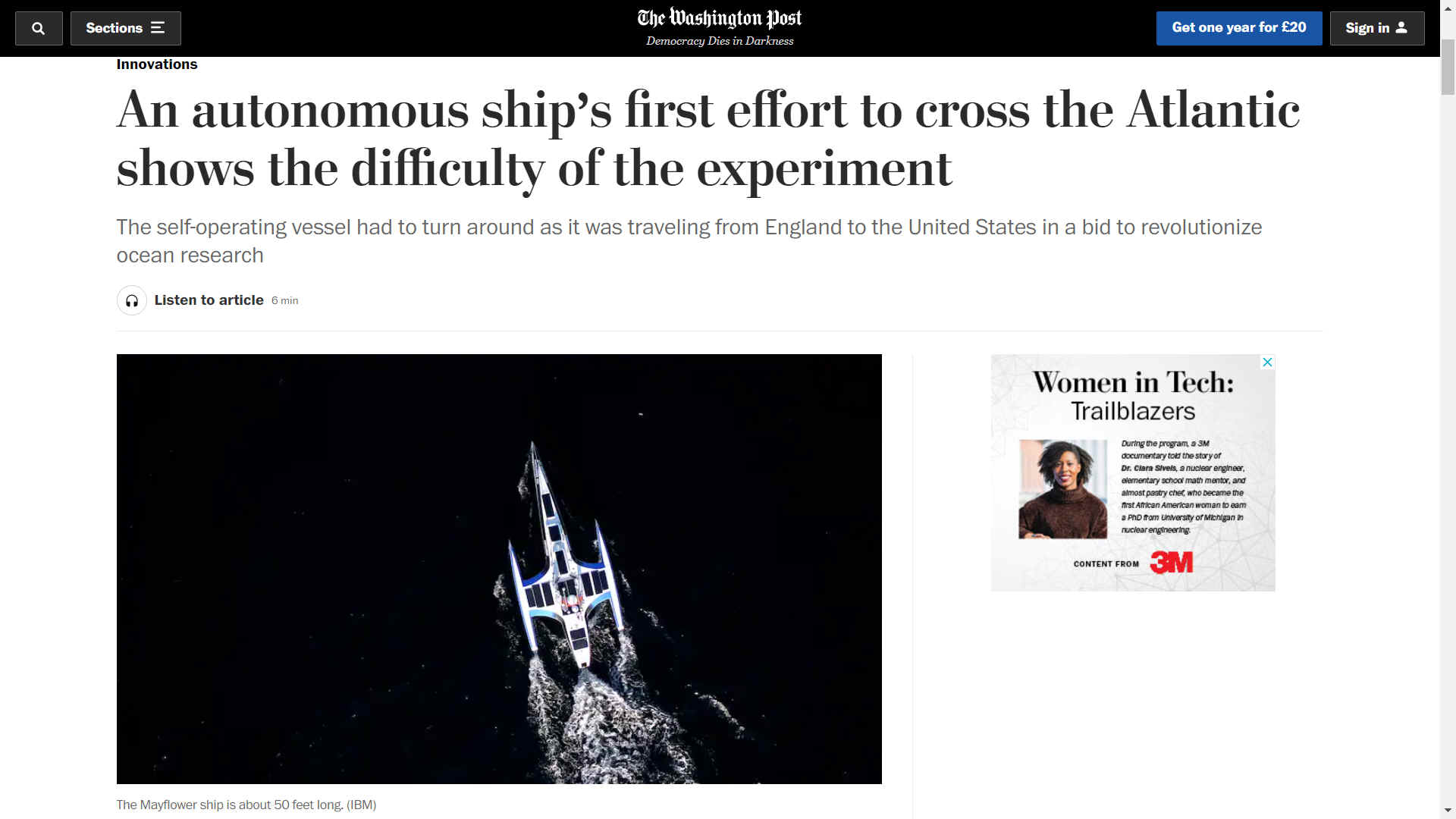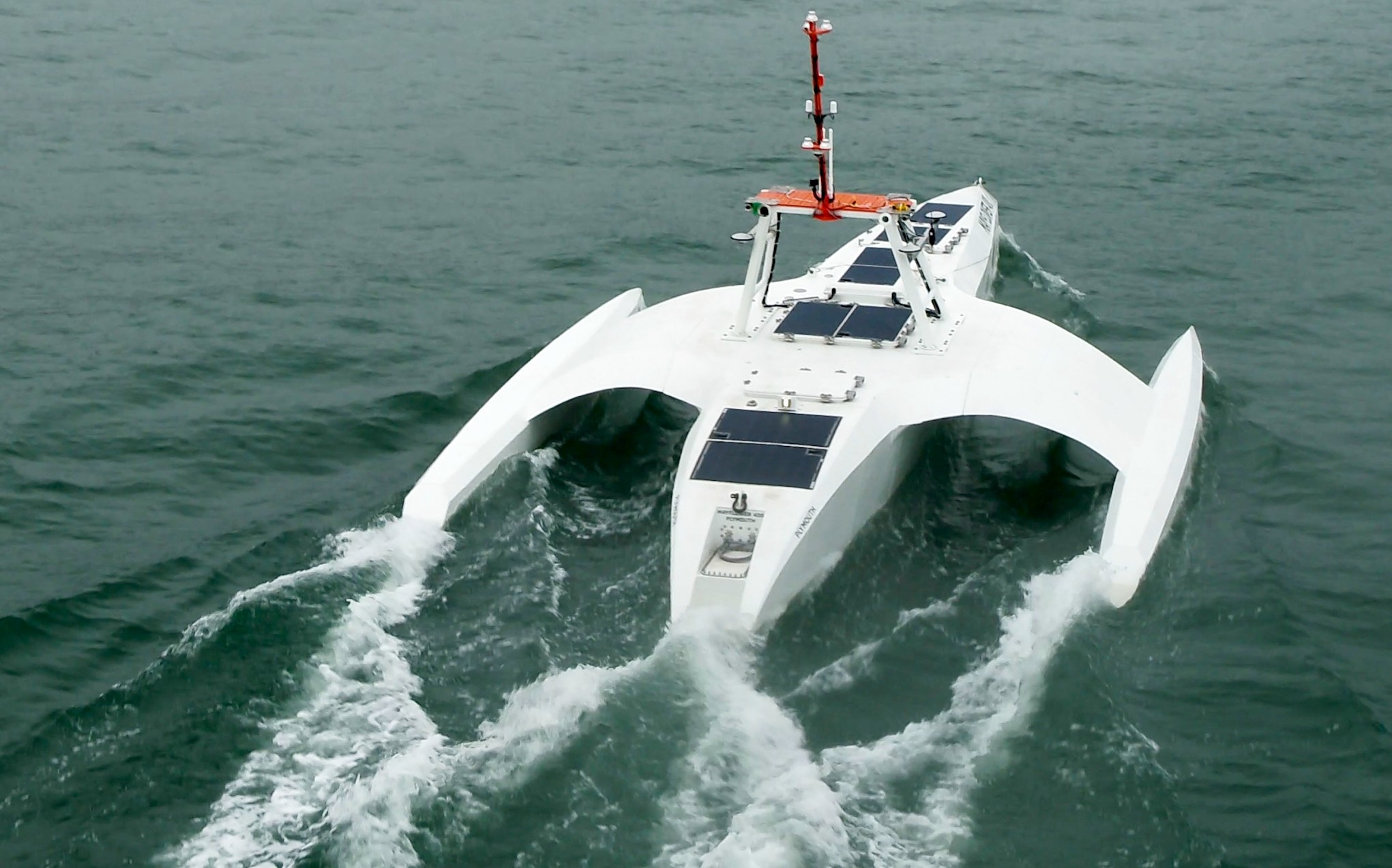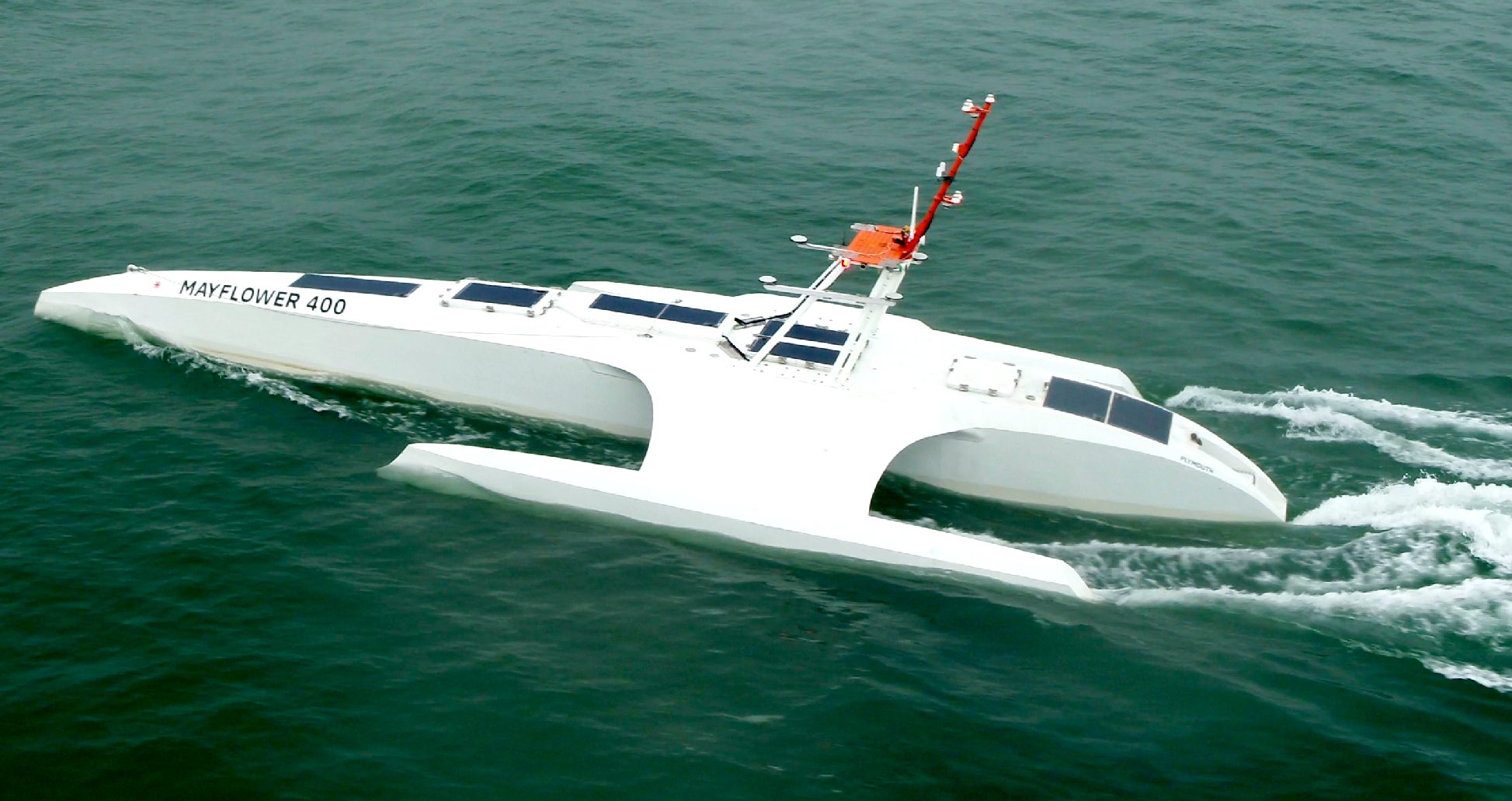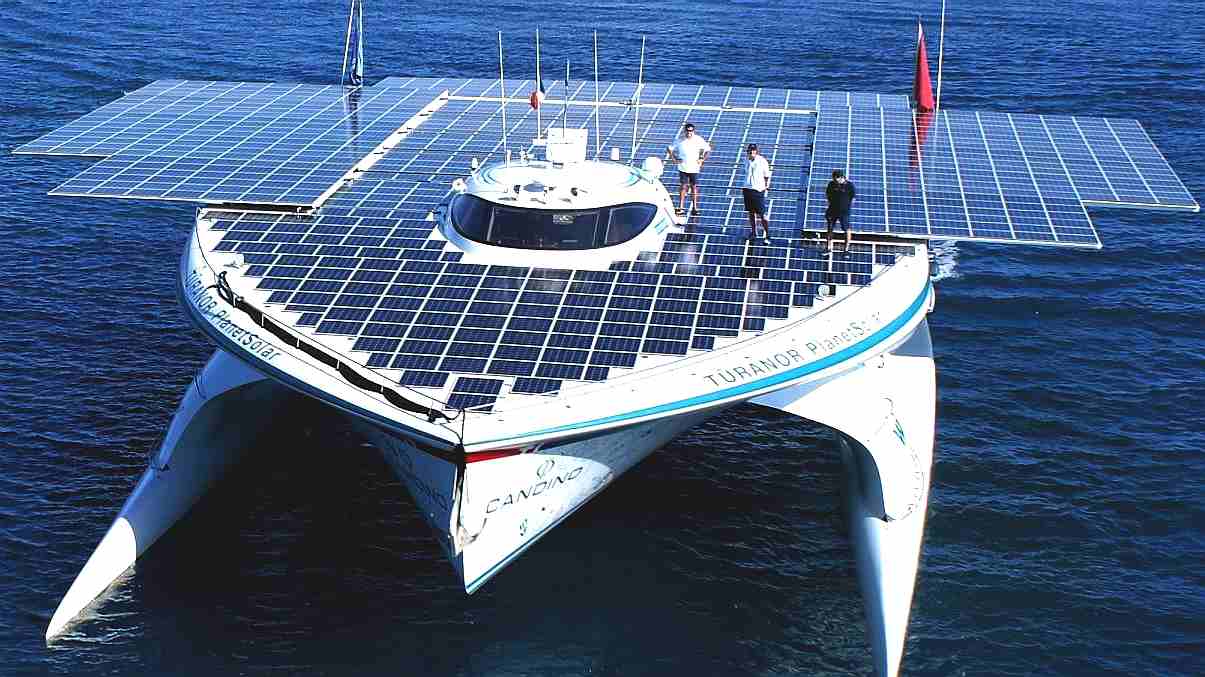
MAYFLOWER
PILGRIMS VOYAGE - MAS's direction of travel is the reverse of the
Scout and Voyager autonomous Atlantic
attempts that took advantage of trade winds. The Mayflower will be
heading into prevailing winds and currents. If sail powered, she would need to tack. But powered by a
diesel
engine, with support from the deck mounted solar panels, there may be no need for
that - except, that we saw her struggling when out at sea. Energy from nature is used to power the onboard AI and satellite
communications. Many media reports inaccurately refer to wind power as a
feature of the MAS, but you can plainly see that there is no wind
turbine or wing-sail on this craft.
AN
AUTONOMOUS SHIP'S FIRST EFFORT TO CROSS THE ATLANTIC SHOWS THE
DIFFICULTY OF THE EXPERIMENT
According
to this media report, the self-operating vessel had to turn around as it was traveling from England to the United States in a bid to revolutionize ocean research.
The live dashboard recorded yet more detail until it was switched off (we
think).
Just over 400 years after the Mayflower made its revolutionary voyage from England, across the Atlantic Ocean toward the Americas, a futuristic sea vessel with the same name set sail following a similar path. Only this time, there was no captain or crew onboard. Instead, the vessel would use
radar to peer into the
horizon, artificial intelligence to understand what’s around it and
solar panels to power the journey.
But the so-called “AI Captain” wasn’t equipped to realize the boat was under distress and needed to return to port for help. That order had to come from someone onshore.
“It’s disappointing,” said Brett Phaneuf, co-founder of the ocean research nonprofit Promare and co-director of the Mayflower Autonomous Ship project. “We still don’t know exactly what happened. But out of an abundance of caution, we have to get her back.”
IBM and Promare had dispatched the 49-foot autonomous boat into the waters off the coast of
Plymouth, England, on Tuesday. The robotic boat was set to traverse the seas alone for the next few weeks until it reached Plymouth, Mass., the town where pilgrim travelers settled in 1620. But overnight
Thursday (17th June), the ship-shaped android developed a “minor mechanical issue” that was significant enough for Promare to temporarily abort the mission.
The original Mayflower faced a few false starts too, having to turn around twice for repairs before successfully completing its 66-day
transatlantic pilgrimage. The
robotic version was 350 miles from its home base, with only 10 percent of the journey completed, when it was instructed to turn around.
The modern sea trek originally was supposed to begin in 2020, the year marking four centuries since the historic Mayflower crossing. But the coronavirus pandemic curtailed those plans, and the craft underwent trial runs in the interim. Now it’s navigating international waters with no guide boats to get back to port and trying to avoid inclement weather so that engineers can fix it before sending it back out.
The broader purpose of the endeavor is to collect data related to climate
change, plastic pollution and animal conservation for marine scientists. If it’s successful, the high-tech floating gadget should give researchers a way to study the world’s waterways without sending humans out to sea.
“Studying the ocean can be particularly arduous. It’s lonely, it’s distant, it’s isolated, and it’s fraught with dangers. So it’s not the most efficient way of collecting that data,” said
Rob
High. High is president and chief technology officer at IBM Edge Computing, a division focused on cloud storage and
AI.
The ship’s original schedule had it pausing in several Eastern U.S. ports, including Washington, as it worked its way to the Southeast this summer. It’s unclear when that’ll happen.
Cheshire, United Kingdom-based Promare invested roughly $1
million on materials at the project’s outset, while New York-headquartered IBM led the
tech and science-related parts of the effort. More than a dozen other organizations donated equipment and other services.
So what went wrong? It’s unclear. Early Friday morning, researchers monitoring the voyage realized that the vessel was operating at about half its optimal speed. The issue may be due to a cheap part
un-tethering near the backup
diesel engine, Phaneuf said. But it’s hard to know since cameras pointed at the ship’s internal components don’t capture everything.
“We could probably just go ahead and plod along, but we’re running into the Gulf Stream, we’re running into a couple of storms. Ordinarily that wouldn’t be a big deal. But if you don’t have enough power to keep the boat going through wind currents and waves, we might’ve been stuck out there for a very long time,” Phaneuf added.

The project is the latest in a series of robotic ship endeavors that hope to one day enhance travel and
shipping operations across large bodies of water.
While automakers and tech companies try to figure out how to operate autonomous cars on land safely, researchers and engineering companies are working toward the same thing on the sea.
In April, scientists from Kiel University in Germany unveiled design ideas for a self-piloted ferry meant to work with other forms of local transportation. The Norwegian chemical company
Yara has been fine-tuning its battery-powered, supposedly autonomous containership since 2017. The 260-foot vessel was supposed to launch this year, but the pandemic impacted those plans.
Rolls-Royce and Intel have also announced plans for an autonomous cargo ship.
The Mayflower is a triple-hulled vessel that relies on a combination of wind
turbines [not sure if accurate], diesel and solar power to travel across the ocean. Promare hopes it’ll make the roughly 3,200-mile journey to the United States in a few weeks.
The autonomous Mayflower was built to travel without human intervention, though operators can send messages to the boat. If the message doesn’t come through, the robot continues on with its primary missions.
The ship-shaped floater constantly monitors incoming weather using forecast data from the Weather Company, which IBM owns. It uses six AI cameras and dozens of other sensors to spot and avoid potential hazards, such as animals or other boats. In the months leading to its launch, researchers added an electric “tongue” to “taste” for the ocean’s chemistry and send back information on organic material and
microplastic contamination. There are also microphones to pick up
whale noises.
The vessel’s decisions are made by AI Captain software developed by a partnering firm, Marine AI. The boat can’t
dock
itself, so engineers created a remote control to maneuver it once it approaches landfall. If the mission ever succeeds, the system might one day help guide crewed ships through torturous sea conditions.
“We can augment the humans responsible for navigation,” High said.
“We can assist them in identifying and recognizing hazards that may have gone beyond their notice. We can offer them choices that perhaps they’re not thinking about themselves.”
The eventual voyage to the United States is estimated to take about three weeks, but can vary depending on weather and the path the AI captain chooses to travel.
The vessel’s top speed is a bit above eight knots, or 10 mph, which might seem glacial, but is much faster than the original Mayflower, thought to have averaged just 2 mph. The new vessel is made of
aluminum, whereas the first was made of wood. The original was also much larger, roughly 100 feet long, and carried more than 100 people.
The reinvented Mayflower’s expedition is being live-streamed on a dedicated website showing real-time updates about the ship’s location and
ocean conditions.
IBM hasn’t said what will ultimately happen to the robotic ship after its mission is completed. However, the firm has revealed that it wants to build a fleet of autonomous boats someday. “Even if it fails to make it, we still have an opportunity to learn about that,” High said.
By Dalvin Brown

TRANSATLANTIC
EVENT CALENDAR 2021
The
IBM Mayflower
MAS 400 is an
autonomous
trimaran powered by a
diesel
engine, piloted by a solar powered artificially intelligent
computer
system developed by IBM called 'AI Captain.'
A
BIT OF HISTORY
The
first solar boat to travel around the world was the PlanetSolar,
coming home on the 4th of May 2012. Computing power was not as advanced
as it is today, when PlanetSolar set off on 27th September 2010,
following the Sunshine Route, first shown in London at the 1994/95 Boat
Show. Then in January 2013 a patent specification for a COLREGs
compliant, unmanned autonomous navigation system was filed by a BMS
engineer ( now our IP) with the suggestion in 'Claims' for using a solar
powered trimaran (patent granted 12 June 2019) as a suitable hull
configuration. This patent also included wind energy harvesting as
originally advertised for the Mayflower 400.
JOURNEY
TIME
The original wooden
30-meter Mayflower took 66 days to carry
the Pilgrims,
Founding Fathers from the U.K. to what is now the U.S. The voyage would
have involved a lot of tacking,
because sailing ships cannot sail directly into the wind. But the new
sail-less aluminium
boat should take two to three weeks (14-21 days) depending on how strong
the prevailing trade
winds are, and assuming no technical glitches or marine accidents -
the whole point of the COLREGs
compliant navigation
system.
LINKS,
CONTACTS & REFERENCE
https://www.washingtonpost.com/technology/2021/06/18/mayflower-ibm-autonomous-ship/
https://www.washingtonpost.com/technology/2021/06/18/mayflower-ibm-autonomous-ship/
https://www.washingtonpost.com/lifestyle/kidspost/britain-launches-a-new-high-tech-mayflower-for-ocean-exploration/2020/09/16/a45b0ed8-f82f-11ea-be57-d00bb9bc632d_story.html
https://www.washingtonpost.com/lifestyle/kidspost/britain-launches-a-new-high-tech-mayflower-for-ocean-exploration/2020/09/16/a45b0ed8-f82f-11ea-be57-d00bb9bc632d_story.html
https://www.news4jax.com/business/2021/06/18/ai-powered-mayflower-beset-with-glitch-returns-to-england/
https://www.news4jax.com/business/2021/06/18/ai-powered-mayflower-beset-with-glitch-returns-to-england/
https://oceancrew.org/news/unmanned-vessel-mayflower-set-off-on-a-transatlantic-voyage_19-06-2021/
https://www.autoevolution.com/news/ai-powered-trimaran-mayflower-suffers-glitch-ahead-of-unmanned-atlantic-crossing-163547.html
https://artificialintelligence-news.com/2021/06/18/ai-captain-ibm-edge-ai-powered-ship-mayflower-sets-sail/
https://www.washingtonpost.com/people/dalvin-brown/
https://www.washingtonpost.com/people/dalvin-brown/




